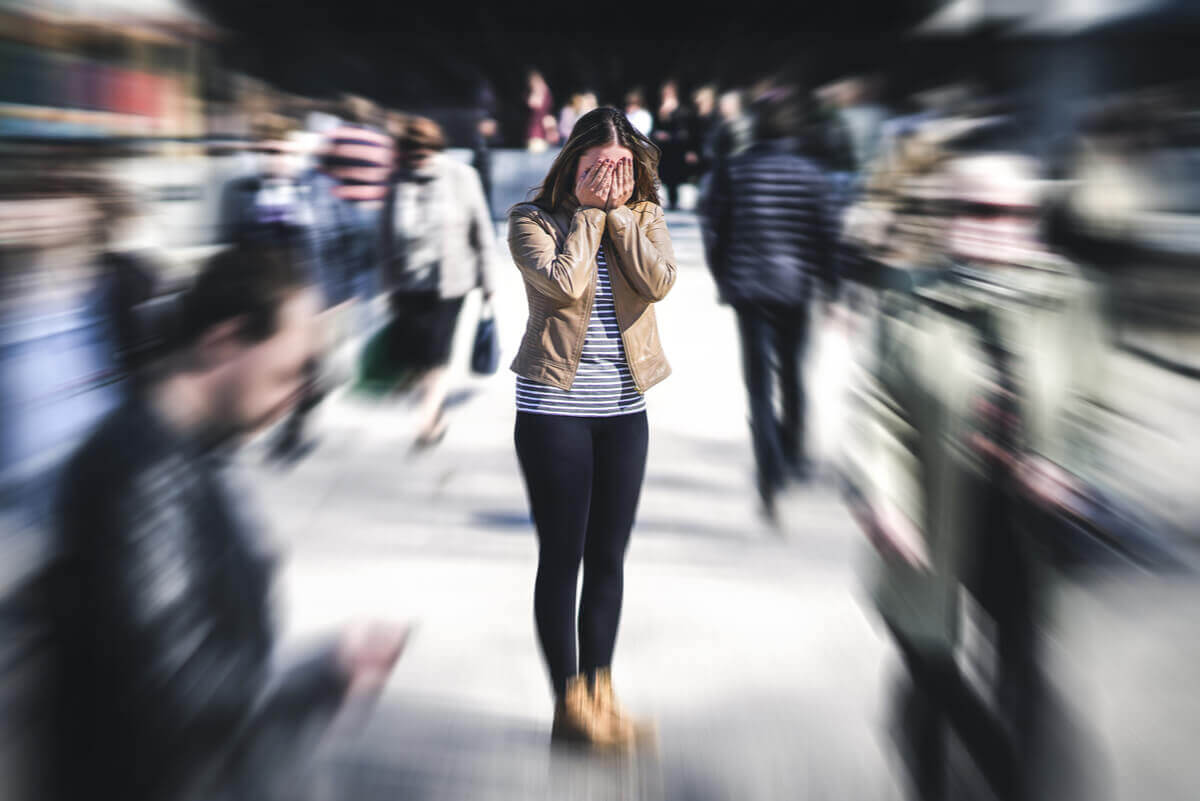What Are the Symptoms of Agoraphobia?


Written and verified by the doctor Leonardo Biolatto
Many different entities have taken on the task of describing the symptoms of agoraphobia. However, they’ve all found that it’s quite a complex disease that each person may experience in different ways. If we had to classify it, we would classify it under anxiety disorders.
The people who suffer from it experience anxiety or exaggerated fear about places or situations in which they feel defenseless, trapped, or embarrassed. For example, this may include open spaces, very crowded places, or even public transportation.
The problem here is that the symptoms of agoraphobia vary greatly, and the phobias sometimes overlap each other. In this article, we’ll explain the most frequent manifestations.
The symptoms of agoraphobia according to the DSM-V
The DSM-V is the Diagnostic and Statistical Manual of Mental Disorders, updated in 2013. It’s the tool that psychologists and psychiatrists usually use to identify different illnesses and conditions. According to this manual, the most frequent symptoms of agoraphobia are the following:
- Feeling anxiety in places where it may be difficult or embarrassing to try to leave. These people are usually afraid of suffering an anxiety attack, and, even worse, of suffering it where they won’t be able to get any help. As a result, crowded places outside the home cause them most distress, such as public transportation or supermarkets.
- This fear means that avoidance behavior patterns often start to develop. For example, if someone experiences anxiety when traveling on a bus, then they’ll avoid buses completely. They’ll change their habits for fear of having an anxiety attack on the bus itself.
- In order to be able to give a definitive diagnosis of agoraphobia, the anxiety attacks should be frequent, or at least one of them should have caused them intense worry or fear. By this, we mean that the person is afraid of suffering another attack, and changes their behavior from that moment on as a result
At this point, we should also emphasize that other mental disorders must be excluded, in order to establish an accurate diagnosis. The reason for this is that certain specific phobias, such as social phobia, often tend to be confused with agoraphobia.

You may be interested in: Anxiety Attacks: What No One Understands
Some examples of symptoms of agoraphobia
The symptoms of agoraphobia, as we’ve already mentioned, vary from person to person. This disorder frequently causes a fear of being in open places, especially when one is alone. However, it can also occur in closed places, such as theaters or movie theaters.
Something else that’s also quite characteristic of agoraphobia is the fear of experiencing an embarrassing situation. Sufferers are afraid of what would happen if they fell to the ground or had an anxiety attack in front of other people. This fear tends to be quite extreme and very intense.
The problem here is that all of this ends up affecting every single area of the person’s life. As we’ve already mentioned, avoidance behaviors will then start to form.
If, for example, they’re afraid of taking public transport to go to work or to carry out a leisure activity, then the avoidance behavior will start to condition how they act and react, and will prevent them from taking part in all sorts of activities.
You might be interested in: 6 Ways to Fight your Fear of Loneliness
Other considerations about agoraphobia
According to an article published in the journal Professional Pharmacy, symptoms of agoraphobia usually appear in late adolescence or early adulthood. Most of these people take refuge more and more in their homes, only going out for what they consider to be necessary.
Agoraphobia tends to appear more in women than in men. Unfortunately, it’s also usually accompanied by depressive symptoms, obsessive thoughts, and social phobia.
If this disease isn’t treated in time, then it ends up becoming chronic and feeds on itself, becoming quite disabling. We must bear in mind that, after all, it is a panic disorder, and, because of that, is also accompanied by physical symptoms.
An article in the Journal of Psychopathology and Clinical Psychology explains that, when a crisis occurs, the heart rate accelerates and the person may experience a sensation of suffocation. Sweating increases, and there’s discomfort and pressure in the chest area.
In extreme cases, this can lead to dizziness and fainting. The anxiety experienced makes the person feel that they’ve lost control, and this can also produce a fear of death.

What you should remember about agoraphobia and its symptoms
What we must keep in mind is that agoraphobia is a complex disorder that can manifest itself in many different ways. These people are afraid of specific situations, such as using public transportation or going to places where they feel they won’t receive help in the event of a crisis.
Because of this, it’s essential that they receive appropriate psychological support and treatment. If not, the disorder may become chronic and end up defining and controlling these people’s lives, preventing them from carrying out their normal daily routine.
All cited sources were thoroughly reviewed by our team to ensure their quality, reliability, currency, and validity. The bibliography of this article was considered reliable and of academic or scientific accuracy.
- Trastornos de ansiedad. Agorafobia y crisis de pánico | Farmacia Profesional. (n.d.). Retrieved August 13, 2020, from https://www.elsevier.es/es-revista-farmacia-profesional-3-articulo-trastornos-ansiedad-agorafobia-crisis-panico-X0213932412678054
- Criterios para el diagnóstico de agorafobia – (DSM5/CIE10). (n.d.). Retrieved August 13, 2020, from https://www.dsm-iv.org.es/indice-del-manual/70106-criterios-para-el-diagnostico-de-agorafobia.html
- Agorafobia (con o sin pánico) y conductas de afrontamiento desadaptativas. Primera parte. (n.d.). Retrieved August 13, 2020, from http://www.scielo.org.mx/scielo.php?script=sci_arttext&pid=S0185-33252006000200022
- Sandín, Bonifacio, et al. “Cuestionario de Pánico y Agorafobia (CPA): Características de los ataques de pánico no clínicos.” Revista de Psicopatología y Psicología Clínica 9.2 (2004): 139-161.
- Tratamiento psicológico del trastorno de pánico y la agorafobia | Clínica Moreno – Psicólogos. (n.d.). Retrieved August 13, 2020, from https://www.clinicamoreno.com/tratamiento-psicologico-del-trastorno-panico-la-agorafobia/
- Sandín, B., Chorot, P., Valiente, R. M., Sánchez-Arribas, C., & Santed Germán, M. A. (2004). Cuestionario de pánico y agorafobia (CPA) : características de los ataques de pánico no clínicos. Revista de Psicopatología y Psicología Clínica, 9(2), 139–161. https://doi.org/10.5944/rppc.vol.9.num.2.2004.3974
- Rodríguez, José Olivares, et al. “Una revisión de los estudios epidemiológicos sobre fobia social en población infantil, adolescente y adulta.” Psicología Conductual 11.3 (2003): 405-427.
This text is provided for informational purposes only and does not replace consultation with a professional. If in doubt, consult your specialist.








